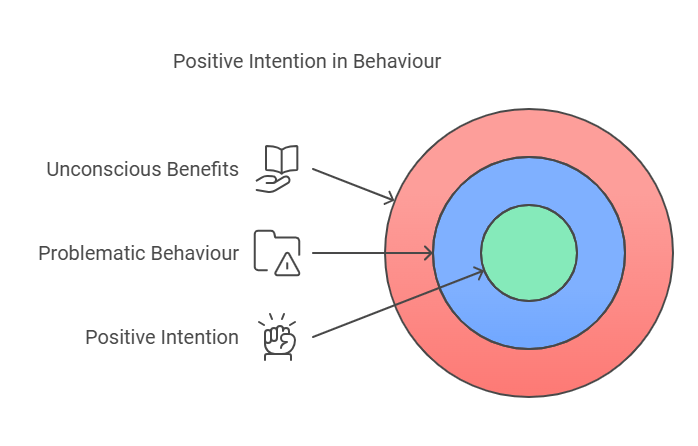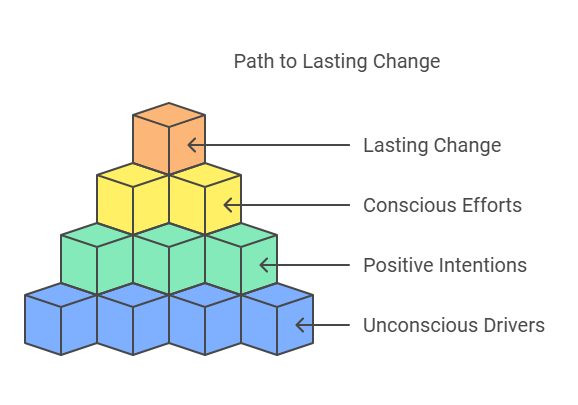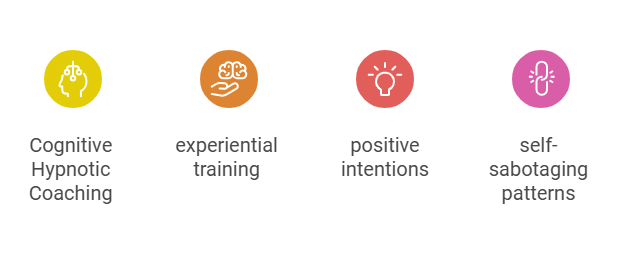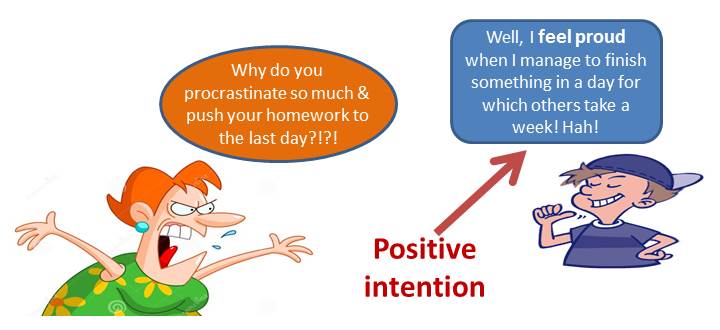The Paradox of Problematic Behaviours
As a therapist or coach, one of the biggest challenges you face is helping clients overcome deeply ingrained behaviours and habits that are causing problems in their lives.
Whether it’s addiction, anxiety, overeating, procrastination or something else, clients often struggle to make lasting changes despite being consciously committed to doing so.
The reason for this lies in the concept of positive intentions or secondary gains.
What is Positive Intention?

Also known as Secondary Gain or Payback, it is the unconscious benefits or payoffs a client derives from continuing the problematic behaviour.
One of the presuppositions of NLP is that every behaviour, good or bad, has a positive intention.
What it means is that every behaviour, no matter how self-destructive it may seem, is being perpetuated because at some level it is fulfilling a positive intention for the client.
Understanding Positive Intention with Examples

- Aches and Pains
Consider someone with a chronic pain condition with no clear medical cause. On the surface, the pain creates significant distress and limitations. But the unconscious secondary gain may be to receive love, care and attention from family members when the pain flares up. The client’s conscious desire to be pain-free is in conflict with this unconscious need. - Procrastination
Take the case of a client who chronically procrastinates and leaves tasks until the last minute, creating immense stress. While debilitating in many ways, this behaviour also fulfills the secondary gains of experiencing an adrenaline rush and sense of accomplishment when they manage to get things done despite the time crunch. - Smoking:
A client wants to quit smoking to improve their health but struggles to do so. The positive intention behind their smoking behaviour could be to manage stress and relax. Every time they feel stressed, smoking becomes their go-to coping mechanism, interfering with their goal of quitting.
Note: these are just examples of secondary gains behind pain, procrastination & smoking. Different people may have different positive intentions behind same behaviours.
Role of Unconscious

These positive intentions originate in the unconscious mind, which has a powerful influence over our behaviours, emotions and physical state. No matter how motivated the conscious mind is to change, as long as these unconscious drivers remain unaddressed, lasting change becomes extremely difficult.
This is where understanding and working with positive intentions becomes absolutely crucial for any therapist, psychologist or coach.
Positive Intention as a justification for Behaviour
There is a common expression ‘focus on the intention, not the behaviour’.
This is true when you wish to change the behaviour, but the problem is that people use this expression to justify a behaviour. They keep using the same behaviour, that creates certain problems, again and again but try to cover it up by saying “my intention was positive”.
Just because there is positive intention, it does not mean that the behaviour is appropriate or helpful (for myself or for others).

To explain this in a simple way, the positive intention behind a thief robbing a bank may be to feed his family or to become rich, yet the behaviour of stealing (moral values aside) may actually end up doing more harm because he might end up in jail and his family members and children might be left to fend for themselves.
Just because there is a positive intention, it does not mean that the behaviour is appropriate or completely helpful.
The truth is that at times the same behaviours (which have positive intention) can actually be harmful or destructive to self or others. It is for this reason that we need to change these behaviours, though the positive intention can make this change difficult.
Therapists Niche
The Missing Link in Conventional Therapy
Conventional therapy approaches often focus solely on the problematic behaviour itself, ignoring the underlying positive intentions driving it. This is akin to treating a symptom without addressing the cause.
No matter how motivated the conscious mind, as long as these unconscious drivers remain unaddressed, lasting change becomes extremely difficult. Relapses or the behaviour resurfacing in a different form are common.
Steps for Changing Behaviour by identifying and addressing Positive Intention
Uncovering Positive Intentions: The First Step

The most effective approaches, like Cognitive Hypnotic Psychotherapy, integrate techniques to first uncover the positive intentions fueling a client’s problematic patterns at a unconscious level. This could involve methods like:
- Meta Model Questions
- N-Step Reframing
- Parts integration and negotiation through hypnotherapy
- Working with metaphors and symbolic representations
- Other delayering techniques to shed light on deeply buried positive intentions
Aligning Conscious and Unconscious Desires
Once the positive intention has been identified, the next step is to find alternative, healthy behaviours that can meet that same intention without the negative consequences. This creates an internal alignment where all parts of the client’s mind are working towards the same objective.
For instance, with the client suffering from chronic pain, the new behaviours could include scheduling more quality time with loved ones, engaging in enjoyable activities together, or cultivating other sources of care and connection. For the procrastinator, it could mean setting realistic goals, implementing better time management strategies, and finding healthier ways to experience challenges and a sense of mastery.
Anchoring New Patterns Through Conditioning
Anchoring these new behaviours through hypnotherapy and conditioning them as habitual responses helps them stick at an unconscious level. This systematic approach of addressing positive intentions and replacing counterproductive behaviours minimizes resistance and dramatically increases the chances of lasting change.
The Missing Skillset in Therapy
Despite its proven benefits, working with unconscious positive intentions remains an underutilized area. Many psychologists and coaches lack training in this approach or the specific skillset required to uncover and re-pattern the unconscious drivers of behaviours. This leads to them getting stuck in an endless cycle of attempting to fight the conscious symptoms without ever addressing the root cause.
Mastering Positive Intention Work: A Game-Changer

Overcoming this requires a dedicated, experiential training program that equips practitioners with a comprehensive framework and set of tools to effectively explore, understand and re-code the positive intentions keeping clients trapped in dysfunctional patterns. Cognitive Hypnotic Coaching and Psychotherapy provides exactly that.
As a therapist, the biggest game-changer was learning how to navigate the unconscious positive intentions of my clients, shares Misba Shah, a practicing psychologist in Mumbai. I’d been struggling for years with clients who would make progress but inevitably slip back into old habits. Once I started looking at the deeper secondary gains and benefits they were deriving from their behaviours, and found ways to get their entire mind on board with the changes, the results became astounding. Clients were finally able to make shifts that lasted.
Mamta Sharma, a transformational coach based in Canada, shares a similar experience. Understanding positive intentions has allowed me to help my clients overcome self-sabotaging patterns that had been holding them back professionally. By aligning their behaviours with their deeper unconscious motivations, the changes feel completely natural and sustainable.
Become an Agent of Lasting Transformation
Whether you are a psychologist, therapist, counselor or coach, mastering the art and science of positive intentions is a gamechanger. It allows you to address the real roots of clients’ behaviours and create transformation at a core level.
Cognitive Hypnotic Coaching provides comprehensive training to equip you with this crucial skill-set through a blend of advanced therapeutic modalities. Become a true agent of change and uplift your clients’ lives in ways you never imagined.
Enroll for the Cognitive Hypnotic Coaching Diploma today and unlock the power of unconscious change work.

